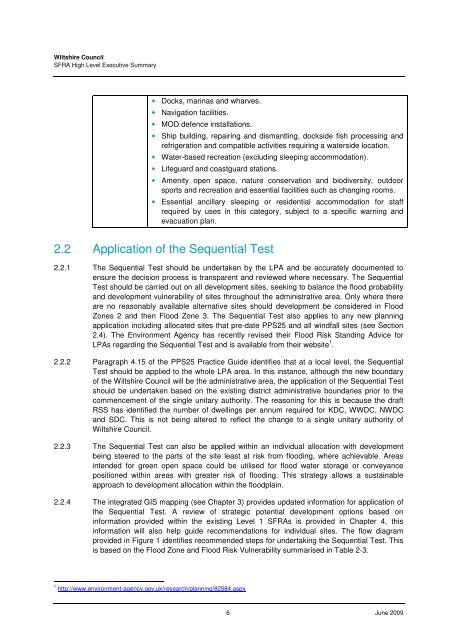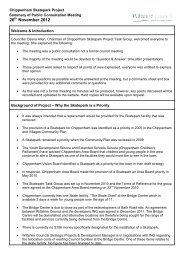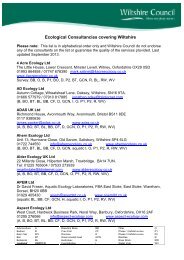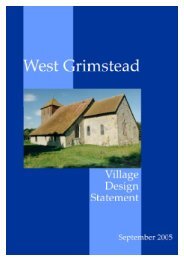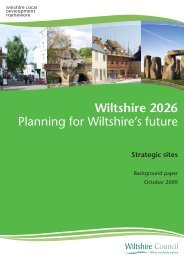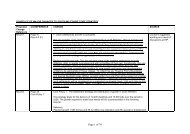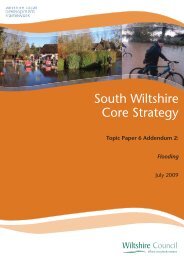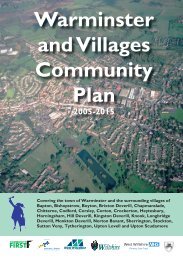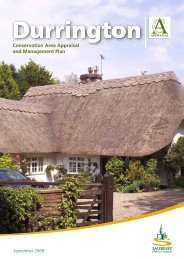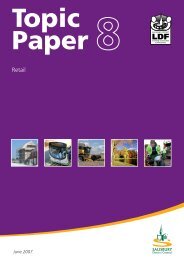Strategic Flood Risk Assessment - Wiltshire Council
Strategic Flood Risk Assessment - Wiltshire Council
Strategic Flood Risk Assessment - Wiltshire Council
You also want an ePaper? Increase the reach of your titles
YUMPU automatically turns print PDFs into web optimized ePapers that Google loves.
<strong>Wiltshire</strong> <strong>Council</strong>SFRA High Level Executive Summary• Docks, marinas and wharves.• Navigation facilities.• MOD defence installations.• Ship building, repairing and dismantling, dockside fish processing andrefrigeration and compatible activities requiring a waterside location.• Water-based recreation (excluding sleeping accommodation).• Lifeguard and coastguard stations.• Amenity open space, nature conservation and biodiversity, outdoorsports and recreation and essential facilities such as changing rooms.• Essential ancillary sleeping or residential accommodation for staffrequired by uses in this category, subject to a specific warning andevacuation plan.2.2 Application of the Sequential Test2.2.1 The Sequential Test should be undertaken by the LPA and be accurately documented toensure the decision process is transparent and reviewed where necessary. The SequentialTest should be carried out on all development sites, seeking to balance the flood probabilityand development vulnerability of sites throughout the administrative area. Only where thereare no reasonably available alternative sites should development be considered in <strong>Flood</strong>Zones 2 and then <strong>Flood</strong> Zone 3. The Sequential Test also applies to any new planningapplication including allocated sites that pre-date PPS25 and all windfall sites (see Section2.4). The Environment Agency has recently revised their <strong>Flood</strong> <strong>Risk</strong> Standing Advice forLPAs regarding the Sequential Test and is available from their website 1 .2.2.2 Paragraph 4.15 of the PPS25 Practice Guide identifies that at a local level, the SequentialTest should be applied to the whole LPA area. In this instance, although the new boundaryof the <strong>Wiltshire</strong> <strong>Council</strong> will be the administrative area, the application of the Sequential Testshould be undertaken based on the existing district administrative boundaries prior to thecommencement of the single unitary authority. The reasoning for this is because the draftRSS has identified the number of dwellings per annum required for KDC, WWDC, NWDCand SDC. This is not being altered to reflect the change to a single unitary authority of<strong>Wiltshire</strong> <strong>Council</strong>.2.2.3 The Sequential Test can also be applied within an individual allocation with developmentbeing steered to the parts of the site least at risk from flooding, where achievable. Areasintended for green open space could be utilised for flood water storage or conveyancepositioned within areas with greater risk of flooding. This strategy allows a sustainableapproach to development allocation within the floodplain.2.2.4 The integrated GIS mapping (see Chapter 3) provides updated information for application ofthe Sequential Test. A review of strategic potential development options based oninformation provided within the existing Level 1 SFRAs is provided in Chapter 4, thisinformation will also help guide recommendations for individual sites. The flow diagramprovided in Figure 1 identifies recommended steps for undertaking the Sequential Test. Thisis based on the <strong>Flood</strong> Zone and <strong>Flood</strong> <strong>Risk</strong> Vulnerability summarised in Table 2-3.1 http://www.environment-agency.gov.uk/research/planning/82584.aspx6 June 2009


